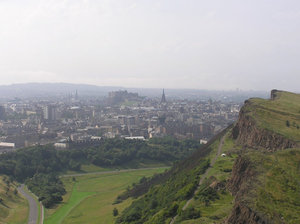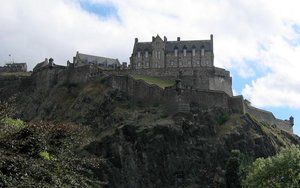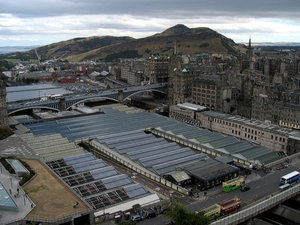Edinburgh
|
|
ScotlandEdinburgh.png

Edinburgh (pronounced ), Dùn Èideann () in Scottish Gaelic, is a major and historic city on the east coast of Scotland on the south shore of the Firth of Forth, and in the unitary local authority of City of Edinburgh. It has been the capital of Scotland since 1437 and is the seat of the country's home rule government. The city was one of the major centres of the enlightenment led by the University of Edinburgh. The Old and New Towns of Edinburgh were listed as a UNESCO World Heritage Site in 1995. In the census of 2001 Edinburgh had a total resident population of 448,624.
Edinburgh is well known for the annual Edinburgh Festival, the largest performing arts festival in the world, and for the Hogmanay street party. At the time of the art festivals the population of the city doubles. The city is one of the world's major tourist destinations, 13 million visitors a year roughly.
| Contents |
Origins of "Edinburgh"
The origin of the city's name is understood to come from the Brythonic Din Eidyn (Fort of Eidyn) from the time when it was a Gododdin hillfort, perhaps, as David Nash Ford (http://www.earlybritishkingdoms.com/articles/nenniuscities.htm) suggests, when it was the home of the mid-6th century King Clinog Eitin whose epithet records the place name.
After it was besieged by the Bernician Angles the name changed to Edin-burh, which some have argued derives from the Anglo-Saxon for Edwin's fort, possibly derived from the 7th century Northumbrian king Edwin. However, since the name apparently predates King Edwin, this is highly unlikely.
The first evidence of the existence of the town existing as a separate entity from the fort lies in an early 12th century charter, generally thought to date from 1124, by King David I granting land to the Church of the Holy Rood of Edinburgh. This suggests that the town came into official existence between 1018 (when King Malcolm II secured the Lothians from the Northumbrians) and 1124.
The charter refers to the recipients (in Latin) as "Ecclisie Sancte Crucis Edwinesburgensi". This could mean that those who drafted the charter believed Edwin to be the original source of the name and decided to derive the latinisation from what they believed to be the ancient name. It could also mean that at some point in the preceding 600 years the name had altered to include a "w". If the latter scenario was the case then it was soon to change; by the 1170s King William the Lion was using the name "Edenesburch" in a charter (again in Latin) confirming the 1124 grant of David I.
Documents from the 14th Century show the name to have settled into its current form; although other spellings ("Edynburgh" and "Edynburghe") appear, these are simply spelling variants of the current name.
Other names
The city is affectionately nicknamed "Auld Reekie" (Scots for Old Smokey).
Some have called Edinburgh the "Athens of the North", for a variety of reasons. The earliest comparison between the two cities showed how they had a similar topography, with the Old Town of Edinburgh performing a similar role to the Acropolis. Both then had flatter, fertile agricultural land sloping down to a port several miles away. Although this arrangement is common in Southern Europe, it is rare in Northern Europe. The 18th century intellectual life, sometimes referred to as the Scottish Enlightenment, was a key influence in gaining the name. Such beacons as David Hume and Adam Smith shone during this period. Having lost its political importance, some hoped that Edinburgh could gain a similar civilising influence on London as Athens had on Rome. Also a contributing factor was the later neoclassical architecture, particularly that of William Henry Playfair, and the National Monument (see below). One writer has said, facetiously, that the "Reykjavik of the South" would be more appropriate!
Edinburgh has also been known as "Dunedin", deriving from the Scottish Gaelic, Dùn Èideann. Dunedin, New Zealand, was originally called "New Edinburgh", and is still nicknamed "The Edinburgh of the South".
The Scots poet Robert Fergusson sometimes referred to the city as "Edina" in his work.
Some Scots refer to the city affectionately and informally as "Embra".
The Centre
The historic centre of Edinburgh is divided into two by the broad green swath of Princes Street Gardens. To the south the view is dominated by Edinburgh Castle, perched atop an extinct volcanic crag, and the long sweep of the Old Town trailing after it along the ridge. To the north lies Princes Street and the New Town. The gardens were begun in 1816 on marsh land which had once been a loch, the Nor' Loch.
Some 70 million years ago several volcanic vents in the area cooled and solidified to form tough basalt volcanic plugs, then later a glacier swept from west to east, exposing rocky crags to the west and leaving a tail of material swept to the east. At the castle rock this tail formed a narrow steep sided ridge, declining in height over a mile till it meets general ground level at Holyrood. At the same time, the glacier gouged out ground to each side, leaving the ravine of the Grassmarket and Cowgate to the south, and the swampy valley of the Nor' Loch to the north.

This formed a natural fortress, and recent excavations at the castle (described in Excavations within Edinburgh Castle by Stephen T. Driscoll & Peter Yeoman, Society of Antiquaries of Scotland Monograph Series no.12 1997) found material dating back to the Late Bronze Age, as long ago as 850 BC.
In the 1st century the Romans recorded the Votadini as a British tribe in the area, and about 600 the poem Y Gododdin using the Brythonic form of that name describes warriors feasting in Eidin's great hall.
The map co-ordinates of the centre of Edinburgh are approximately Template:Coor dm.
Old Town
OldTownEdinburgh.jpg
The Old Town has preserved its medieval plan and many Reformation-era buildings. One end is closed by the castle and the main street (the Royal Mile) leads away from it; minor streets (called closes or wynds) bud off the main spine in a herringbone pattern. Large squares mark the location of markets, or surround major public buildings such as St Giles Cathedral. This layout, typical of the old quarters of many northern European cities, is made especially picturesque in Edinburgh, where the castle perches on top of a small mountain and the main street runs down the crest of a ridge from it.
The old city is also home to some of the earliest "high rise" residential buildings. During the 1700s the Old Town had a population of about 80,000 residents. However, in modern times it has declined dramatically to just 4,000 residents. The population was for a long time reluctant to build outside the defensive wall, so, as the need for housing grew, the buildings became higher and higher. However, many of these buildings were destroyed in the Great Fire of 1824. They were then rebuilt on the original foundations. This led to changes in the ground level and the creation of many passages and vaults under the Old Town.
On December 7 2002, another major fire in the Old Town engulfed part of the Cowgate. It destroyed the famous comedy club, The Gilded Balloon, and much of the Informatics department of the University of Edinburgh, including the comprehensive AI library.
New Town
Edinburgh_from_the_Illustrated_London_News_1868.jpg
The New Town was an 18th century solution to the problem of an increasingly crowded Old Town. The city had remained incredibly compact, confined to the ridge running down from the castle. In 1766 a competition to design the New Town was won by James Craig, a 22-year old architect. The plan that was built created a rigid, ordered grid, which fitted well with enlightenment ideas of rationality. The principal street was to be George Street, which follows the natural ridge to the north of the Old Town. Either side of it are the other main streets of Princes Street and Queen Street. Princes Street has since become the main shopping street in Edinburgh, and few Georgian buildings survive on it. Linking these streets were a series of perpendicular streets. At the east and west ends are St Andrew's Square and Charlotte Square respectively. The latter was designed by Robert Adam, and is often considered one of the finest Georgian squares in Britain. Bute House, the official residence of the First Minister of Scotland, is on the north side of the square.
Sitting in the valley between the Old and New Towns was the Nor'Loch, which had been both the city's water supply and place for dumping sewerage. By the 1820s it was drained. Some plans show that a canal was intended, but Princes Street Gardens are what was created. Excess soil from the construction of the buildings was dumped into the valley, creating what is now The Mound. In the mid-19th century the National Gallery of Scotland and Royal Scottish Academy Building were built on The Mound, and tunnels to Waverley Station driven through it.
The New Town was so successful that it was extended greatly. The grid pattern was not maintained, but rather a more picturesque layout was created.
Leith
Leith is the port of Edinburgh. It still retains a separate identity from Edinburgh, and it was a matter of great resentment when in 1920 Leith was merged into Edinburgh. Even today the parliamentary seat is known as 'Edinburgh North and Leith'. With the redevelopment of Leith Edinburgh has gained the business of a number of cruise liner companies who now provide cruises to Norway, Sweden, Denmark, Germany and the Netherlands. Leith also boasts the Royal Yacht Britannia, berthed behind the new Ocean Terminal.
Viewpoints
The varied topography of the city includes several summits which command sweeping views over Edinburgh.
To the southeast of central Edinburgh stands the eminence known as Arthur's Seat, overlooking Holyrood House and the Old Town beside it. The crag is a collection of side vents of the main volcano on which Edinburgh is built. The volcano slipped and tipped sideways, leaving these vents as the highest points for miles around. Arthur's Seat is now part of Holyrood Park, originally owned by the monarch and part of the grounds of the Palace of Holyroodhouse. It contains Britain's largest concentration of geological SSSIs, as well as providing the people of Edinburgh with spectacular views of and from Arthur's Seat and somewhere to relax after a long day in the city.
To the northeast, overlooking the New Town, is Calton Hill. It is topped by an assortment of buildings and monuments: two observatories, Nelson's Monument (a tower dedicated to Admiral Horatio Nelson), the old Royal High School (once almost the home of a devolved Parliament), and the unfinished National Monument, which is modelled on the Parthenon from the Athenian Acropolis and is nicknamed Edinburgh's Disgrace.
Sports
Edinburgh has two professional football clubs; Hibernian and Heart of Midlothian. Both play in the Scottish Premier League, Hibernian at Easter Road Stadium in Lochend and Hearts at Tynecastle Stadium in the Gorgie area. Although Edinburgh is Scotland's capital, the Scottish national team play usually, but not always, at Hampden Park, Glasgow.
Rugby union internationals and some football and American football games are played at Murrayfield stadium, owned by the Scottish Rugby Union. Edinburgh's professional rugby team, Edinburgh Rugby, play in the Celtic League at Meadowbank.
Edinburgh has also hosted the 1970 British Commonwealth Games and the 1986 Commonwealth Games.
Economy
The economy of Edinburgh is largely based around the service sector, with tourism and banking being particularly important. The Bank of Scotland was founded in 1695, by an act of the original Scottish Parliament, and is now part of the HBOS group, who have kept their headquarters in Edinburgh. The Royal Bank of Scotland was founded in 1747 by Royal Charter, and is now the fifth largest bank in the world by market capitalisation. In 2006 they will move into their new purpose built headquarters at Gogarburn, near the Edinburgh City Bypass.
The New Town has traditionally been home to many companies, but modern needs have caused many to relocate. Immediately to west of the city centre is the Terry Farrell master planned Exchange business district, which now houses major employers such as Scottish Widows, Standard Life, the Clydesdale Bank and Baillie Gifford. Edinburgh Park is a business park located in the west of city, near Edinburgh Airport, and it now has its own railway station. Following the opening of the Royal Bank's new headquarters, there will be around 20,000 people working in the western outskirts of the city.
Brewing is a traditional industry, and while the closure of the Fountainbridge brewery in 2005 will leave no large-scale brewing in the city, Scottish & Newcastle still retain their headquarters in the city.
On March 12, 2004, Edinburgh was granted Fairtrade City status.
Politics
Scottish_Parliament.jpg
On a national level, the city of Edinburgh is represented at both Holyrood and Westminister.
At the Scottish Parliament, it returns six MSPs from the constituencies of Edinburgh North and Leith, Edinburgh Central, Edinburgh East and Musselburgh, Edinburgh Pentlands, Edinburgh South and Edinburgh West. It dominates the Lothians parliamentary area, which returns a further seven MSPs.
In the House of Commons, it is represented by the five constituencies of Edinburgh South, Edinburgh West, Edinburgh South West, Edinburgh North and Leith, and Edinburgh East. The seat of Edinburgh Central ceased to exist with redistricting prior to the UK general election, 2005, as did that of Edinburgh Pentlands.
Dialect
Edinburgh Dialect (http://www.scots-online.org/grammar/edinburgh.htm)
See also
- List of Provosts and Lord Provosts of Edinburgh
- Areas of Edinburgh
- Edinburgh Festival
- Art Galleries
- Museums and Libraries
- Other Features of Interest
- Universities and Colleges
- Schools
Famous residents
- Alexander Graham Bell, telephone pioneer, was born in Edinburgh
- Tony Blair, UK Prime Minister, was born in the city and attended its exclusive Fettes College high school
- William Burke and William Hare, noted grave-robbers, plundered the city's graveyards
- James Clerk Maxwell, Scottish physicist
- Arthur Conan Doyle, the creator of Sherlock Holmes, was born in the city's New Town
- Sean Connery, actor
- Field Marshal Douglas Haig was born in Edinburgh
- David Hume, philosopher and historian
- John Knox, Protestant Reformer, lived in Edinburgh and "John Knox's House" is preserved in the High Street
- John Napier, mathematician, mainly remembered for the invention of logarithms
- John Porteous, captain of the city guard, lynched during the Porteous Riots of 1736
- David Roberts, 19th century painter and lithographer
- J. K. Rowling, Harry Potter author, wrote her first book in an Edinburgh coffee-shop
- Adam Smith, economist, author of "The Wealth of Nations"
- Robert Louis Stevenson, novelist, wrote fondly of the city before moving to Samoa
- James Young Simpson, an obstetrician who conducted the first experimental use of chloroform for anaesthesia
- Nigel Tranter (1909-2000), historian, writer, lived in Edinburgh
- Irvine Welsh, novelist, author of e.g. Trainspotting, is from Edinburgh
- Ian Rankin, author of the "Inspector Rebus" series of crime thrillers, attended Edinburgh University
- Alexander McCall Smith, author of The No. 1 Ladies' Detective Agency series of books, lives in Edinburgh.
- Sir Walter Scott, (1771-1832), novelist, was born in Edinburgh.
Twinned cities worldwide
Edinburgh is twinned with several cities across Europe and throughout the rest of the world. These include:
- Munich, Germany
- Florence, Italy
- Nice, France
- Vancouver, Canada
- Kyiv, Ukraine
- Aalborg, Denmark
- San Diego, USA
- Dunedin, New Zealand
External links
- Wikitravel (http://wikitravel.org/en/Edinburgh)
- The University of Edinburgh (http://www.ed.ac.uk/)
- EdinburghGuide.com - what's on Edinburgh. (http://www.edinburghguide.com/)
- Architecture of Edinburgh (http://scotland.archiseek.com/edinburgh/index.html)
- City of Edinburgh Council (http://www.edinburgh.gov.uk)
- Edinburgh Fringe Festival website (http://www.edfringe.com)
- BAA - Edinburgh Airport information (http://www.baa.com/main/airports/edinburgh/)
- Lothian and Borders Fire Brigade (http://www.lbfire.org.uk)
- National Galleries of Scotland (http://www.nationalgalleries.org/)
Other places with the same name
The name Edinburgh has also been given to places elsewhere in the world, mainly by Scottish settlers:
- Edinburgh, Indiana, United States of America
- Edinburg, New York, United States of America
- Edinburg, Texas, United States of America
The Scots Gaelic name Dùn Èideann has also been given to other cities, including:
ca:Edimburg cy:Caeredin de:Edinburgh es:Edimburgo eo:Edinburgo fr:Édimbourg ga:Dún Éideann id:Edinburgh it:Edimburgo he:אדינבורו la:Edimburgum lt:Edinburgas nl:Edinburgh ja:エディンバラ no:Edinburgh pl:Edynburg pt:Edimburgo ro:Edinburgh ru:Эдинбург fi:Edinburgh sco:Edinburgh sv:Edinburgh th:เอดินบะระ zh:爱丁堡


